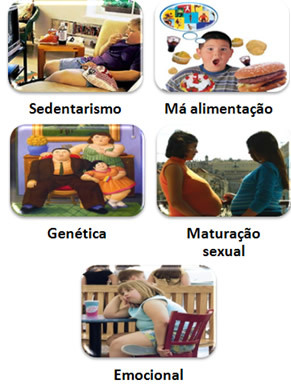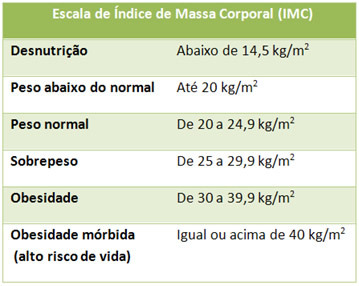Between March 5th and 9th, 2012, the Ministry of Health launched a campaign to combat obesity in children and adolescents in the country. The target of this campaign was public schools in several municipalities.
This initiative is important because many factors can trigger obesity. But before looking at these factors and seeing if you can include yourself among those who are truly overweight, see what obesity is:

Many factors can trigger this imbalance, but the main ones are:
*Eating habits: there is an increasingly frequent consumption of processed foods, usually with high calorie content at the expense of saturated fat and cholesterol. In addition, skipping meals and eating fast food are part of the lifestyle of many teenagers;
*Sedentary lifestyle: this sedentary lifestyle is mainly due to technological advances, as seen among children and teenagers who spend hours watching television, playing video games or in front of the computer;
* Genetic factors: many parents, family members, doctors and other authorities who deal with children, such as teachers, tend to neglecting the need for treatment against obesity, as they think this will resolve itself when the child becomes adolescent. However, the chance of obese children and adolescents remaining obese in adulthood is very high, as the relationship between the overweight of parents and children is great and results from the sharing of heredity and the environment;
* Emotional problems: emotional problems, such as depression, can lead to overeating;
* Sexual maturation: especially in the case of girls, early sexual maturation is related to increased height and weight, muscle development and increased fat deposits.

To find out if you fit among those who are obese, an obesity reference standard was established, called Body Mass Index (BMI). This index is made using the following mathematical formula:
Do not stop now... There's more after the advertising ;)

If the result of this calculation is greater than 30 kg/m2, the person is considered obese.
For example, let's say a teenager is 1.5 m tall and weighs 70 kg. Your BMI would be calculated as follows:
BMI = 70 kg
(1.5 m)2
BMI = 70 kg
2.25 m2
BMI = 31.1 kg/m2
This result indicates that the adolescent is obese and needs treatment.
It is true that there may be a variation with age and sexual maturity, especially with regard to teenagers. However, BMI has been considered a good indicator of obesity in adolescents, showing an important correlation with skinfold measurements and densitometry.
To minimize errors in the results, it is customary to use in the case of children and adolescents, the percentile BMI, which indicates the relative position of the child's or adolescent's BMI in relation to other children and adolescents of the same sex and age.
Below is a diagram showing the weight classification categories for children and adolescents:

For adults, we have below a BMI scale for all the results that can be obtained:

If you find yourself in the overweight, obese, or morbidly obese ranges, ask yourself what steps you should take to maintain a normal, healthy weight. The important thing is to diagnose the causes of obesity, which is a chronic disease, and attack them, facing the problem and taking the correct treatment.
By Jennifer Fogaça
Graduated in Chemistry
Would you like to reference this text in a school or academic work? Look:
FOGAÇA, Jennifer Rocha Vargas. "How do I know if I'm obese?"; Brazil School. Available in: https://brasilescola.uol.com.br/saude-na-escola/como-saber-se-estou-obeso.htm. Accessed on June 27, 2021.



